What’s the difference between hazard and risk?
In ordinary language, the distinction is rather spongy. It’s quite otherwise in a food safety context.
Here, on the one hand, you can use a hazard-based assessment. This is fairly simple: all you have to do is find a detectable quantity of a harmful material in a product.


One scientific paper puts it this way: “In hazard-based approaches, simply the presence of a potentially harmful agent at a detectable level in food is used as a basis for legislation and/or risk management action.”
Risk-based approaches, on the other hand, view the hazard in a broader context, trying to “establish health-based acceptable or tolerable daily intakes.” (For EPA’s discussion of this topic, see here).
Both processes begin by establishing the presence of a hazard. Risk-based assessments, however, view the actual danger in a fuller context, such as exposure levels and in some cases the actual presence of the material in humans. The article cites “increasing evidence that direct measurements (biomonitoring) in humans usually demonstrate much lower exposures than those derived from exposure estimates.”
Another important difference: “Risk-based approaches to food safety will always carry a certain degree of uncertainty, both in relation to the toxicological data and the exposure estimates,” the scientific article notes.
The problem with risk-based assessments, then, is the inevitable uncertainties. The problem with hazard-based assessments is that they focus on the mere presence of the toxic agent, possibly overestimating the actual danger.
The technicalities of each type of assessment certainly go far beyond the scope of this article. For the produce industry, perhaps the most relevant topic has to do with the types of assessment used in various countries. As a generality, the United States and United Kingdom tend to rely more on risk-based assessments, while nations in the European Union gravitate toward hazard-based assessments.
This fact helps explain why agrichemical restrictions in EU nations are often stricter than those in the U.S.
It’s important for the produce industry to recognize this fact, in the first place, because these distinctions can and will affect exports to European countries.
In the second place, EU bans on certain chemicals tend to increase fears of these products in the American public.
Perhaps the most visible case is that of glyphosate—aka Roundup—familiar as a backyard weed killer, but used in huge quantities as a herbicide in commercial agriculture. In 2015, the International Agency for Research on Cancer (IARC) declared the chemical to be a “probable human carcinogen.”
But the European Food Safety Authority (EFSA) evaluated the risk of harm. In short, one used a hazard-based approach; the other, a risk-based approach.
Glyphosate was approved for continued use in the EU for a five-year period, starting in 2017. (The review period for renewal is taking place over this year.) But many nations, such as France, have imposed restrictions of their own, decreeing a 50 percent reduction in the use of the substance, starting in 2021.
Barbara Pompili, the French minister of ecological transition, “was adamant that not even halving the use of the substance is enough to fully eliminate its long-term negative effects on the environment, soil, food and human health.”
The U.S. Environmental Protection Agency, on the other hand, has relied upon a risk-based assessment to maintain the position that glyphosate is safe if used according to label instructions.
Debates about agrichemical safety will continue into the foreseeable future. In order to understand the situation as fully as possible, it’s important to know the difference between these types of assessments.



